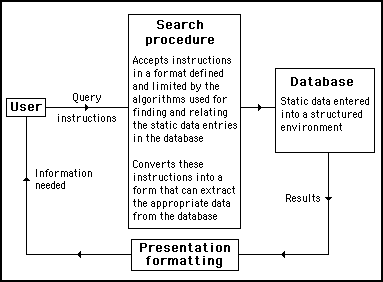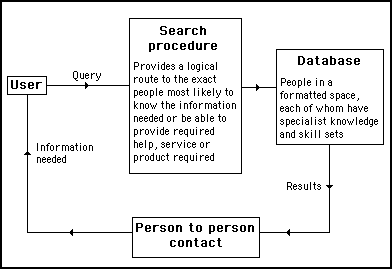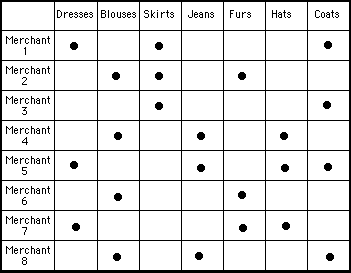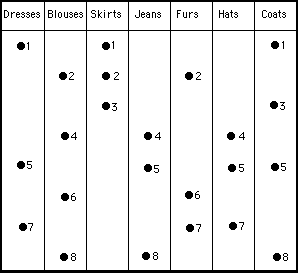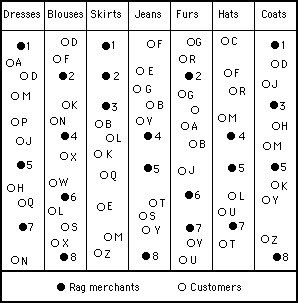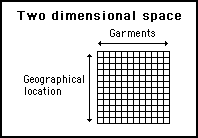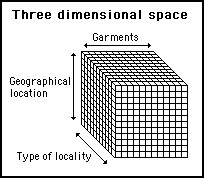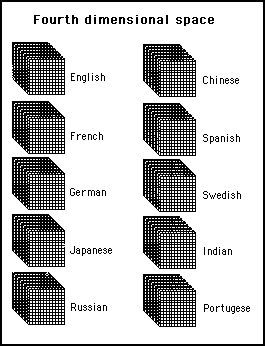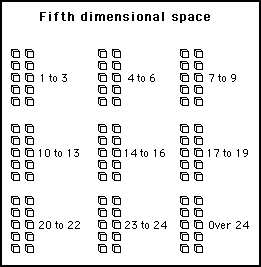Chapter 9
A formatted people space
Welcome to the world of the entrepreneur
The last chapter illustrated how subtle the differences can be between top down and bottom up strategies. It revealed a fuzzy separation between ideas and opportunities. It presented conceptual components as enigmatic entities without definition or tangible form.
Not surprisingly, several of the readers of the last chapter, who'd had no experience of being entrepreneurs, were left feeling bemused and frustrated. They'd been looking to be led directly into creating an e-business. Instead, they felt they'd been getting a kaleidoscope of inconsequential theory, a smoke screen, that was obscuring the real purpose of any e-business: which is to make money.
Reading the various posts at some of the tables in the virtual cafe, it was quite clear that some of the readers were still looking for algorithms: step by step guides as to how to set up a money making business. They wanted to be given roles, shown what to do. It didn't occur to them that the world of the entrepreneur isn't that simple; if it were, everyone would be an entrepreneur.
To an entrepreneur, such vagueness is power for the course because creating businesses isn't about following known paths and clear directions, it is about peering into a world of uncertainty and creating order where none exists. It is about adapting experiences from the past to deal with the present; it is about mixing and matching concepts, people and skill sets to produce systems of interaction.
To illustrate the essence of entrepreneurial activity, and to show how chance and opportunity replace ideas and planning I'll explain how years of training as an electronic systems engineer, together with an intensive study of marketing and investment strategy led to me sorting out piles of used clothing in rag merchants' yards.
From there, we'll see how the lessons learned in the smelly rag yards of England can be applied to the high tech world of electronic communications - proving that entrepreneurship in e-business is really about concepts, not technology.
Rags to riches
In the first book in this trilogy – The Entrepreneurial Web – I described how I made a radical change of life style, going from the formal and structured environment of banking and stockbroking to join the hippies in a hippie fashion market that had just opened in Kensington High Street in West London.
Hippies and fashion may not seem a logical combination, but, the hippies in Kensington soon found out that there were plenty of people willing to pay to buy into their life style. Wannabe hippies were prepared to buy the kind of clothes the hippies were wearing to be able to emulate them – even if it were only at weekends. As most of the hippies were making their own clothes, or finding them in used clothes shops, it didn't take much extra effort to make or find a few more that could be sold to the many who wanted to copy them.
As soon as the emulators started wearing the clothes that were being worn by the hippies, the hippies started to wear different clothes so they could look different from the wannabes. As soon as the emulators saw the hippies wearing new clothes, they wanted them as well. Pretty soon, a whole industry came into existence with hippies working out new and exotic ways to dress and this creativity feeding a continuous demand for their wares.
Recognise the pattern? Isn't this very similar to the strategy that Bill Gates had described as being the formula for success used by Microsoft? Hadn't they found themselves in an environment, pioneered new product in that environment and sold all their learned know how and techniques to those following on behind?
I'd joined in this trading environment in the then currently fashionable area of "old clothes" (later to be called "antiquarian clothes" when some of the garments became so sought after they cost considerably more than new clothes). I'd partnered with a girl in a stall in Kensington market selling 1920's and 1930's garments that we'd search for in the many used clothes shops and flea markets that were dotted around London.
One day, as we were driving around looking for used clothes shops, my partner spotted the characteristic look of a 1920's velvet dress poking out of a lorry load of old rags that were on their way to a rag yard. The lorry was parked outside a workman's cafe and we decided to go in to find the driver of the lorry.
To my surprise, the lorry driver turned out to be an ex boy friend of my sister, a person I'd known since school days. Over a cup of coffee in the cafe, he explained that he was now in the rag business and had a large warehouse in Fulham sorting through tons of old clothes every week. He then invited us to go back with him to his warehouse to see if there were any more 1920's or 1930's dresses lying around.
When we arrived at his warehouse, we found it contained a gigantic mound of assorted used garments (known as rags). This was feeding a conveyor belt. Along the conveyor belt were several sorters who were sorting through these rags to divide them into various categories. Although they'd sort out a few useables that could be sold to traders in the flea markets and the second hand shops, they were mainly concentrating on sorting the rags by the type of material they were made from: woolens, cottons, synthetics, fur, leather, etc.
My friend explained that he bought in mixed rags at a certain price per ton. When sorted into the various categories, each category sold to specialist processors at a much higher price than the price he was paying for the unsorted mixed rags. Effectively, the act of sorting the rags was increasing their value. It was a very simple formula and he was finding the business highly profitable.
The astute reader will likely spot the parallel with information on the Web. The information equivalent of the pile of unsorted rags at one end of the rag merchant's warehouse is the vast assortment of information available on the Web. Added value can be created by a sorting process that turns an unsorted conglomeration into sorted categories that are immediately usable.
This simple formula is the key to the success of all media products: newspapers, magazines, books, directories, search engines, etc. A value is created because the information they contain has been selected, sorted and categorised. This is why Web sites that provide just content are not profitable in their own right because that content doesn't acquire value until it has been passed onto somebody who can make profitable use of it. In isolation, all information on the Web is the equivalent of just another rag on the unsorted pile of rags in a rag merchant's warehouse.
The value of the sorting process really hit home when the rag merchant invited us to look through his unsorted rags to see if we could see any more 1920's or 1930's dresses. My partner and I spent an hour sifting through piles of smelly garments and came across only three items of interest.
The rag merchant waved me away when I offered to pay for them and told us we could come along at any time and take what we wanted. As generous as his offer was, the thought of spending much more time sifting through mounds of smelly clothes didn't fill me and my partner full of excitement . I suggested to the merchant that perhaps his sorters could pull out these garments for us while they were doing their sorting.
The merchant gave us a condescending smile and explained that he'd love to help us but if his sorters were looking out for these 1920's and 1930's clothes they would lose their rhythm and slow up his whole operation.
It made perfect sense, but, having just spent the past year writing about investment strategy I had a little model in my head that fitted this scenario. Investment value was based upon a continuous regular revenue stream. Once a revenue stream could be defined the value of a business could be determined.
The 1920's and 1930's clothing garments would appear at random in the unsorted pile. Over time, and averaged out, this would create a continuous revenue stream as far as my partner and I were concerned. However, to the rag merchant, pulling out these garments represented a cost in terms of loss of efficiency. The problem then became one of finding a way to turn this loss into a profit for the rag merchant.
I thought about my partner and I sorting randomly through the mound of rags for an hour and finding three items. The rag merchant had four sorters and they were working forty hours a week. A quick calculation told me that if they could uncover items at the same rate as my partner and I, there was every chance that they could uncover 240 items a week. This would be quite a considerable sum of money in sales. The capitalised value of such a regular income could greatly increase greatly the value of both mine and the rag merchant's businesses.
I then asked the rag merchant to do a trial run for a week to get his sorters to pull out the kind of clothes I was looking for. I offered him a compensation for the decrease in efficiency and he agreed (probably just to humour an old friend).
As a compromise, it was decided that the sorters wouldn't inspect every garment carefully, but, just throw to one side any item that roughly fitted the characteristics of 1920's and 1930's clothing. This would select for the type of fabric, the length, patterns and various other criteria that could quickly be associated with the styles and fashions of that era.
After a week, I returned to the rag merchant's warehouse and found that the sorters had put aside quite a sizeable pile. With my partner, I went through this pile and found a quarter of them to be sellable items. A quick estimate of the price I could sell them for gave me a ball park figure as to what this revenue stream was worth to me.
I then estimated how much the rag merchant would be paying his sorters every week. I compared this with the value of the revenue stream I would be getting if the sorters put aside all these garments regularly. I then realised that I could probably afford to pay all the sorters' wages out of the profit I'd be making on the sale of the dresses they'd be putting aside to me.
I then divided the estimated weekly wage bill by the number of sellable items the sorters had pulled out over the week. This gave me a price per item that I could offer to pay to the rag merchant. This delighted the rag merchant when he realised that by simply adding an additional sorting category he could eliminate one of his major outgoings: the weekly wage bill.
Parallels can be drawn here with many situations on the Internet. If information is compared to a valuable garment lying in piles of unsorted used garments, the value isn't in offering the information, the real value emerges only when this random information is selectively extracted from a background of noise: selected to specifically target a particular type of need.
Looking at Web based businesses today, it is evident that the pure content providers and the general cataloging and indexing operations are struggling to be viable. On the other hand, the businesses targeting the particular information needs of small niches are consistently successful and profitable.
The model of the rag merchant also illustrates another important characteristic of a successful business: the ability to extract several revenue streams from the same processing activity. This allows bottom up strategies to come into play where a single revenue stream by itself may appear insubstantial, but, facilitates the creation of many others. This, as we shall see, in the next chapter, can be applied very effectively to produce not only revenue streams but sources of funding.
The reader might note that this particular example is unique to my own personal experience. It is my equivalent of Sherlock Holmes's treatise on the one hundred and fourteen varieties of tobacco ash. The abstractions from my unique experiences in the rag yards can be regarded as some of the conceptual components that appear in my personal solution space.
Everyone has or can create their own equivalent of these personally unique conceptual contributions to the models they build. These can then be used to help turn opportunities into profitable solutions. Not only can these Sherlock Holmes's treatise on the one hundred and fourteen varieties of tobacco ash equivalents be used personally, the astute entrepreneur will look out for them in others – so as to be able to include them in their own repertoire of conceptual components.
Scaling by duplication
After the arrangement with my Fulham rag merchant had been working satisfactorily for a few months, I began to realise that most of the rags were coming from the merchant's local West London area. I then asked my friend about other areas and he gave me the addresses of other rag merchants who covered different areas.
With the Fulham arrangement as a working example, it wasn't difficult to convince other rag merchants to try out the deal. It wasn't long before I had supplies from several rag sorting warehouses all over the London area. Pretty soon, I was getting in more stock than I could sell, so, I opened another sales outlet. The success of this sales expansion then brought into mind the possibility of covering the whole country.
Within a year, I'd made arrangements with practically every major rag merchant in England: effectively filtering most of the 1920's and 1930's garments that were discarded in the country every week, down to my warehouse in London. This massive and regular supply enabled me to open a large store in the then fashionable Carnaby Street and also wholesale garments to other stores all over Europe.
A chance observation, an unlikely coincidence, a few conceptual models and a substantial business had been created out of apparently nothing. This is the essence of entrepreneurial activity.
The concept of space
The business of selling old clothes appears to have no relationship at all with the modern hi-tech world of electronic communications until the organisation is abstracted away from the actual business. What we then find is a large space (the area of England) covered with collection points where the weekly produce of a commodity in the local area is brought together and sorted.
At each collection point, people sift through the local produce to pull out items according to certain broad criteria. A human expert then undertakes a further examination of a particular category and makes a more precise selection based upon finer detail. These selections can then be transferred to a single collection point: where all the filtered items from the whole space converge.
The importance of this abstraction is that it highlights the fact that the whole process is organised through a hierarchy of humans who use nothing more than the unique ability of the human brain to differentiate between patterns in a complex environment. There are very few instructions, no complicated procedures or algorithms. The whole system relies on the processing power of the human brain to extract a range of specific items from a very large variety of unsorted possibilities.
Even more interesting is the ease and efficiency by which such a human system can be controlled and directed. It can be made to respond and adapt almost immediately to any changes in demand. For example, it was very easy to modify the garment filtering system to find 1940's clothes when they became fashionable. Silk scarves, embroidered blouses, long skirts, etc. could all be filtered out when they were in demand. Just a few worlds of spoken instruction could cause the whole system of people to react almost immediately to any changes in customer demands or fashion trends.
With an abstraction of this system, it is easy to see how information can substituted for garments. It is easy to see how the space of the country of England can be replaced by the space of the Internet.
This provides yet another useful conceptual component to put into my solution space.
A real life opportunity presents itself
To illustrate how the abstraction of this garment sorting system might be applied to create an e-business solution out of an opportunity, let's take a real life opportunity that appeared in my solution space while I was writing chapter 4 of this book.
The opportunity took the form of a problem presented by Tillman Pearce – the medical director of an oncology business unit for a large pharmaceutical company in France. Posting to a table of people in my virtual cafe, he wrote:
I work in the pharmaceutical industry developing new cancer therapies. As such I am aware of current treatment options around the world and am aware that most patients around the world are never presented with all the options (this is as true in the US as elsewhere). I have therefore considered the possibility of developing a web-based service for informing patients (or doctors) of therapeutic options for specific patient/disease states.
Looking in the Internet, one finds a profusion of sites purporting to provide such services. All these services (ALL) provide standardized documentation on basic categories of disease. For example, look up colon cancer -- within a day or two of effort you can find about 30 sites providing info on colon cancer. They all state basically the same thing and 99% are based on what is currently approved in the United States.
The problem is, nobody has "generic" colon cancer. Rather, you are a male or female of a certain age; your performance status and liver, heart, kidney function are either excellent, good, poor, or other; your cancer has been partially or completely removed; the histology is either of good or bad prognosis; you have or have not received certain prior therapies (chemo and/or radiation).
Depending on these (and other) variables, specific therapies are considered highly recommended, possibly recommended or not recommended. Furthermore, you might be interested in knowing what treatments are offered not only in your country, but in other parts of the world (a drug I work with has been available in France since 1996 and for various reasons is not yet available in the US; I am aware of about 150 studies around the world with this agent -- the "gold standard" site, that of the US National Cancer Institute, lists about 15 studies).
A valuable service would necessarily CUSTOMIZE the recommendations to your particular situation and provide comprehensive information. One of the prior commentators suggested we might be heading to an econsultancy. For me, this idea took hold since the café is composed of "consultants" but also because we are in a position to provide customized advice. The above cancer consultancy could also be provided by a network of doctors and oncology nurses or by using decision algorithms backed up by modular software components (OOPS).
So, my main contribution at this point would be to point out a major anomaly today is that most services are providing standardized products rather than harnessing the power of OOPS to provide customized products in real time and at mass production costs. Furthermore, I would attribute this striking anomaly to the fact that those who have had the idea of health econsultation services have not had a deep understanding of their customers' needs (tailored information to the specifics of the patient/disease state) but rather provided superficial services hoping to quickly capture eyeballs (revenues) to maybe later invest in something with more value added.
Similarly, consultancies have not really understood what is involved in providing meaningful advice to patients and hence have not understood how their technologies might satisfy the needs. [An aside, my problem is that people expect information to be free, so I haven't figured out how a viable business model even if I think I understand the patient needs and technological solutions] Can anyone provide other examples of Internet services providing standardized products?
Tillman Pearce
As soon as I read this post, an opportunity popped into my solution space. It was not that I could see an immediately profitable situation – it was that the conceptual components at my disposal could recognise a possible solution to this problem.
The reader might like to pause here for a moment before reading on, to see if this problem Tillman Pearce identifies also pops into their solution space. How would you solve for this problem?
The first clue
I must admit that part of the solution was currently in my mind because, at the time I received Tillman Pearce's e-mail, I was making preparations for a talk I was to give at BOT 2001 ( a seminar being organised by Internet.com and taking place at the Fairmont Hotel in San Francisco in January 2001). The talk was to be entitled: "Using bots to create a living database".
The principle behind a living data base is that it consists of a system of people rather than information. This, as you might recognise, is similar to the rag sorting business described above and is also a constantly reoccurring theme running through the books in this trilogy. The principle tenet is that people are needed where uncertainty, change and volatility render logical and algorithmic search techniques useless. Only the human brain can provide the kind of intelligence needed.
To appreciate the advantage of a living database, let's first examine a conventional database – an outline view of which is shown diagrammatically in Figure 9.1.
Figure 9.1
Outline of a conventional database
Information in a conventional database can be cleverly formatted and indexed to facilitate retrieval. Data can be sorted, mixed, matched, compared and selected using all manner of criteria and conditionals, but, the algorithms used have to be predetermined and require direct human reprogramming to change them.
Such databases are adequate as long as the data is reasonably long lasting and can be maintained within a constant format. But, if there are any chaotic or unpredictable elements of change, there will be problems because it will be extremely difficult to arrange for the database to question the validity of data, anticipate the possibility of error or check that it has become redundant or is incomplete.
Many important categories of information and knowledge – such as the expanding and evolving areas of technology – have such a high level of unpredictable volatility that reliable output is prohibitively expensive to maintain. The databases quickly become choked with redundant and conflicting information, the efficiency soon declining to a point where the information that is retrieved has very little practical value. This is the problem confronting anyone who would want to create the kind of database that Tillman Pearce is looking for.
In these situations, when accurate information and knowledge is not readily available, people resort to the age old custom of asking around: finding somebody who may have the information they need. This involves a bottom up strategy – following a trail, routed through person to person contact, with one piece of information leading to the discovery of another until the information or the solution to a problem is found.
In pre Internet days, the telephone was perfectly adequate for this kind of strategy. Databases could take the form of directories, yellow pages, etceteras – that listed contact names – where bottom up, seek to find strategies could begin a search for people who might point to any kind of ill defined, fuzzy or elusive types of information that might be needed.
Such a strategy is illustrated in a generic form in figure 9.2.
Figure 9.2
A strategy to find ill defined, fuzzy or elusive types of information must involve asking people. A system needs to be devised to locate the appropriate people to ask
Figure 9.2 shows how it is necessary to have some method of formatting the space where people can be found and a procedure for finding the most suitable people to provide any required information. In pre Internet times the database would be a directory of names, separated into various categories. The search procedure would involve nothing more complicated than choosing people in an appropriate category to question.
Viewed in the diagrammatic form, it becomes obvious that in the massive communication environment of the Internet and with the rapidly changing and evolving nature of knowledge and information, similar problems will occur as with a conventional database.
The number of people needing to be included in the people space would be impossibly large. There would be too many categories and the categories chosen would have to be constantly changed and added to. There would be too many ways in which the people space can be formatted. Even for the people that could be listed and categorised, there would be no certainty that they could provide currently accurate or up to date information. There would be no precise way of determining who knew what and the extent and exact nature of their knowledge.
With these thoughts in mind, let's turn to the opportunity offered by the problem of creating a treatment database for cancer patients as outlined by Tillman Pearce.
Creating a database of cancer treatment options
As Tillman Pearce explained, the requirement is for a fully comprehensive, universal cancer treatment database covering the very many different kinds of options and treatment strategies available in different clinics and hospitals in different parts of the world. Both the medical profession and cancer patients have a great need for such a resource.
The main reasons why such a much needed resource hasn't emerged yet are:
1) There are too many variables involved: type of cancer; location and size of cancer; progression of cancer; age and sex of patient; health of patient; genetic variation of patient; prior therapies; combination therapies; trial treatment strategies, etc.
2) Technology and scientific knowledge relating to cancer treatment is continuously changing and evolving.
3) There are a very large number of people involved in the treatment of cancer. They are moving around in different areas of specialty as new types of treatment become available through research and new technologies.
These reasons suggest that an effective and efficient, universal cancer treatment information resource would require a massive and highly complex database, where the content would have to be continuously updated. The costs and the organization necessary for the establishment and maintenance of a conventional database would certainly prove prohibitive.
Clearly, a conventional solution is out of the question. If there is to be any solution at all it will require a radically new approach. This is where we can start to think in terms of using some of the unique properties of the Internet to create a database that will be self organising and self maintaining.
Similarity to the problems facing all e-businesses
The cancer treatment database problem is very similar to the information seeking problems encountered in the technological world of e-business. In e-business also, there is a great need for up-to-date information that is frustrated by large numbers of variables and the rapidly expanding and evolving knowledge base; not to mention the large number of technical experts and specialists involved.
Despite the vast capacity of the World Wide Web and the low cost of Internet communication and information transfer, the creation of a universal knowledge database has similarly proved impossibly difficult and prohibitively costly to implement.
As an alternative to conventional database solutions, the Internet has naturally evolved networks of people who, as interacting communities, provide living databases of up-to-date information and knowledge. Direct information exchange between humans, rather than algorithms, seems to be the most efficient and cost effective way to search, sort and obtain the type of volatile information involved in electronic communication technology.
This suggests that a solution to the cancer treatment database problem might be to set up a similar living system of information exchange to serve doctors and patients. The trick will be to organise a suitably formatted people space, where people can find each other and which will be economical to build and maintain.
Helping people to do it for themselves
One of the commonest mistakes made by e-businesses is to think from a bricks and mortar perspective and try to build an Internet presence based upon the the notion of providing a fully comprehensive and efficient service for customers or clients. Such an approach to doing business is so universally accepted that it is seldom even considered that there might be a better way. After all, what could be better than using all possible means to find out what customers want and then make every effort to give it to them?
However, the environment of the Internet is not the same as that of the world of bricks and mortar. It is possible to go one better than provide customers with what they want - it is possible to enable customers to provide for themselves.
A service to provide information of cancer treatments is a case in point, where to think solely from the provider's view point clearly highlights the limitations of the quality of service that it is possible to provide. Conventional business thinking would conclude that it is not commercially viable to fully satisfy a customer's need for complete information about available cancer treatments.
However, because of the uniqueness of the communication environment of the Internet, it is possible to do things that wouldn't even be considered in the conventional bricks and mortar world. For example, you wouldn't expect an old economy business to tell their customers they can't help them, but, if the customers got together they could help each other. Yet, this is exactly the kind of thinking that is appropriate in many areas of e-business.
Take this problem of supplying cancer treatment information to patients: a conventional approach to supplying such a service would assume that such a service is impractical because there is too much knowledge to be recorded and even if it could be recorded it would rapidly become outdated. Yet, it must be a fact that all current, up-to-date information must be known somewhere in the world by someone. Isn't it possible to find a way to connect together those who know with those who need to know?
Structural organization, formal rules and procedures are not appropriate for solutions to this kind of problem. It will need an informal, dynamic system that is self building and self maintaining. Such a system might be possible to arrange if natural human motivations can be harnessed to create and drive a self organizing process.
In the world of the Internet, such systems are appearing all the time, as the need for specialty information cause special interest e-mail discussion forums to form spontaneously. It is such just such a natural consequence of mass connectivity that can be called into service to create a database for cancer treatment.
The trick is to provide a suitable framework for this self organisation process to take place. To this end, we can use the abstraction of the system used to extract 1920's and 1930's garments from the mass of garments discarded every week in England.
The reader might want to pause again here, to contemplate how this model might be applied to the problem of making patients aware of available cancer treatments. It is a useful exercise in applying abstractions to seemingly intractable real world problems.
Formatting a people space
In the bricks and mortar world example, of using rag merchants in a system to extract 1920's and 1930's clothing from all the garments discarded every week in England, it is natural to think of the entrepreneur as the sole collector and organiser. All garments would be selectively filtered to the entrepreneur's central base for redistribution to the customers.
Using a paradigm shift, now imagine that it is not the organising entrepreneur who is using such a system to filter garments, but, the customers - each of whom would have their own set of rag merchants to obtain garments exclusively for themselves. In this way, the customers would be able to order exactly what they wanted without having to be limited to the selections chosen by the entrepreneur.
If the customers used the system themselves, the entrepreneur wouldn't have to deal with the rag merchants, nor the customers or their orders. In fact the entrepreneur wouldn't even have to know what the customer wanted or what the rag merchants were supplying. The entrepreneur would be completely outside of the system. It would be completely self organising, with customers going directly to the rag merchants and the rag merchants supplying directly to the customers.
This begs the question: "What would be the role of the entrepreneur?"
To answer this question, it is necessary to consider the main problem each customer would have to face before they could take advantage of this system. How would they find and make contact with rag merchants on their own?. Where would they find those that would be interested in sorting out the particular garments they wanted? The rag merchants would have a similar problem: how would they find the customers who were wanting the kind of garments they were sorting?
From this view point, it is easy to see that the role of an entrepreneur in such a self organising system of supply and demand would be to provide an infrastructure to make it easy for people to find each other.
In the bricks and mortar world of real rag merchants, customers would be able to find rag merchants if an entrepreneur created a directory: listing all rag merchants and their contact details, together with a description of the garments they were sorting. This could be represented as a table: a two dimensional space divided up into rows and columns, as illustrated in figure 9.3. Dots in this diagram represent either:
1) The garments each merchant sorts, or,
2) The rag merchants that sort any particular listed garment
Figure 9.3
Using rows and columns a two dimensional space is created. Each dot in the space represents a merchant (identified by the name in the row) who is sorting out a particular type of article (specified by the description of the column)
The trick now is to imagine each dot in this space as representing a merchant. Conceptually, the diagram then stops being a table and becomes a number of boxes that contain merchants. For example, the part of the space reserved for blouses (the blouses column) becomes a box that contains every rag merchant who sorts out blouses.
If somebody wants blouses, they can be imagined as visiting the box allocated to blouses (the blouse column) where they will find all the merchants in the country who are sorting out blouses.
This situation is illustrated in figure 9.4, where the rag merchants are identified with a reference number (eliminating the need to have them represented as rows in a table).
Figure 9.4
Each category of garment can be thought of as a box that contains several rag merchants. Any rag merchant (each identified by a reference number) can be in several boxes at the same time
In the same way as a merchant can be represented as a dot in a garment space, so can a buyer. Figure 9.5 shows a mixture of merchants and buyers visiting the space allocated to a type of garment that is being sorted or bought. Merchants are identified with numbers and buyers are identified with letters. Using these identifications to obtain the necessary contact details, merchants and buyers can visit an appropriate box to communicate with each other directly.
Conceptually, it is as if the people in each of these garment spaces (boxes) were together in a virtual cafe, where they'd each be free to wander around and talk to each other. Thus, instead of a seeing a tabular representation, you have a picture in your mind of a number of cafes – each attracting a uniquely different group of people who have a particular niche interest.
Figure 9.5
Buyers can be thought of as visiting garment spaces to find rag merchants. Rag merchants can be thought of as visiting the spaces to find buyers for the garments they are sorting. Each garment space can be thought of as a virtual cafe where those present can talk to each other
Using conventional thinking, it is impossible to imagine a database without algorithms that store, sort and search for information. It would seem impossible that a database could construct itself without a team of people entering in all the data. Yet, from figure 9.5, it is easy to see how there wouldn't be any need for algorithms or management – if only rag merchants and buyers were given facilities to enter their own presence in any of the garment spaces.
For example, new rag merchants starting up in business could simply enter their presence into the spaces associated with the articles they were sorting. It would immediately put them into contact with all the buyers who would be looking for those particular garments. They could also enter garment spaces to find out how many people were looking for particular types of garment, giving them a guide as to what garments would be the most profitable to sort..
Similarly, a buyer could enter their presence into the spaces associated with the garments they were interested in obtaining. This would put them in contact with all the rag merchants who were sorting those items.
There wouldn't be a requirement for sorting or searching algorithms on the database side because all the entering and retrieving of data would be done by the rag merchants and buyers when they decided where to enter their presence. Merchants and buyers could add or remove their presence from various different garment spaces, as and when their respective sorting or buying patterns changed.
If merchants and customers are also allowed to add extra columns, to specify additional garments that are being sorted or are wanted, the whole database could be run by the users themselves without the need for any building or maintenance from the server side. In fact, the server side needn't even have any direct contact with the users – because through a self organisation process they would be able to make all the appropriate contacts themselves.
Would such a system work? There is a very good precedence. Napster, the peer to peer networking phenomenon that threatened to bring down the entire music publishing industry worked on a similar principle. During the dotcom bubble at the turn of the century, while other startups were obtaining millions of dollars in funding and failing spectacularly to create viable information systems, Napster, with virtually no capital and little organisation, attracted 12 million people who used Napster's very simple peer to peer networking system to exchange music with each other. Napster did very little more than provide a way for people of similar interests to get in contact with each other directly - and they didn't even format the people space.
Scaling up
The hypothetical example described above assumes a limited number of rag merchants and garment buyers. The number of rag merchants in each garment space is assumed to be quite modest, such that it would be possible for buyers in the space to easily contact all of them to sort out who is the best to deal with.
However, if this were extended world wide, to include every rag merchant on the planet and everyone in the world is allowed to join in, the system would soon become overcrowded. There might be hundreds of rag merchants in the garment spaces and it would be very difficult for buyers to choose between them.
To make life easier, it might be sensible if each garment space were divided up further. Perhaps divided by geographic location, according to where rag merchants were geographically situated. This would reduce the numbers in any particular space and at the same time ensure that buyers didn't waste time trying to deal with merchants whose warehouses were further away from them than they were prepared to travel.
By splitting up the garment spaces in this way the total space would take the form of a two dimensional grid, as shown in figure 9.6. In this diagram, there are twelve garment spaces (columns) divided up into twelve geographic locations (rows). This creates 144 different spaces where rag merchants and buyers can meet.
In each of these areas, there will be fewer people, but, they will each know that they are interested in the same kind of garment and are geographically close to each other.
Figure 9.6
Contact places, where rag merchants and buyers meet, can be spread over a two dimensional grid to increase the efficiency of finding the best contacts
Even though there might be a large number of garment categories and a large number of geographic locations, some of the contact areas might still be over crowded. This problem is easily overcome by adding yet another dimension to the overall meeting space.
Let's say that the type of locality, where the rag merchant's warehouse is situated, is also an important buying consideration. Some buyers might prefer the unsorted garments to be drawn from one type of locality, while others might prefer another. This distinction could provide a third dimension to divide up the total meeting space. This is illustrated in figure 9.7 where by adding twelve categories of locality, the total number of possible contact points is increased from the two dimensional number of 144 to a three dimensional number 1,728.
Figure 9.7
By adding a third dimension, the possible contact places have increased from 144 to 1,728
Adding this third dimension, not only reduces the over crowding, but, also ensures that buyers and sellers are more likely to be compatible. In this three dimensional space, every buyer will know that the rag merchants, who will be in a particular meeting area they choose, will not only be sorting the type of garments they need and be geographically near to them, they will also be drawing stock from the right kind of locality.
Imagine now that there are thousands of different rag merchants of many different nationalities and the customer only speaks one language. They would obviously prefer to deal with only the rag merchants that they can speak with. This can be accommodated by adding a fourth dimension, which will create a different three dimensional space for every language. This four dimensional space is illustrated in figure 9.8, where the three dimensional space is recreated ten times: each to cater for a different language that the merchants and customers might prefer to speak.
Figure 9.8
By adding a fourth dimension, customer can go to the spaces where they'll meet only the merchants who speak their language
This fourth dimension will have the effect of increasing the number of different possible meeting places to 17,280. This will greatly reduce the effect of over crowding and at the same time improve the compatibility of buyers and sellers.
There may be other preferences that a customer might have. If there are so many merchants that that there is still over crowding, a new dimension can be added for every important category. Figure 9.9 shows a fifth dimension being added to allow the customer to also choose the size of the merchants they deal with:
Figure 9.9
A fifth dimension might separate out the rag merchants by the number of sorters they use, as well as by garments sorted, geographic location, type of locality and language spoken. In this diagram, it shows this fifth dimension as consisting of nine groups, each with ten, three dimensional areas
This fifth dimension will increase the number of different places a rag merchant or a buyer can establish a presence to 155,520. This may seem ludicrously excessive for finding rag merchants, but, this is only a simplistic example used to explain the principle. What is of interest is that this same principle can be applied to areas where there are millions of people involved. Then, 155,520 different possible meeting places might seem very sensible indeed.
These diagrams graphically illustrate how the parameters associated with choice can be used to format a people space to increase the efficiency of finding suitable contacts. The significance of this model cannot be underestimated. This is a powerful way to divide up a super large population in order to seek out valuable contacts for information or help.
The creation of such a scenario
Upon first thoughts, this would seem to be an impossible complex scenario to set up, involving much organisation and considerable capital expenditure. However, every entrepreneur has their own little specialty knowledge that can be applied to situations - the equivalent of Sherlock Holmes's treatise on the one hundred and fourteen varieties of tobacco ash. My particular specialty is clones and intelligent agents. These can be used to inexpensive build and maintain such an environment and adapt it for all kinds of information gathering situations where conventional databases would not be viable solutions.
### End of chapter 9 ###
Back to index
Note: This book lead to the creation of the stigmergicsystems.com website
Copyright 2001 - Peter Small
E-mail: peter@petersmall.net
All rights reserved by Pearson Education (Longman, Addison-Wesley,Prentice Hall, Financial Times for FT.COM imprint
